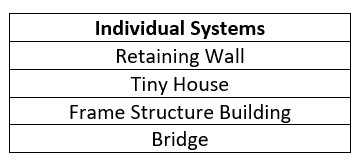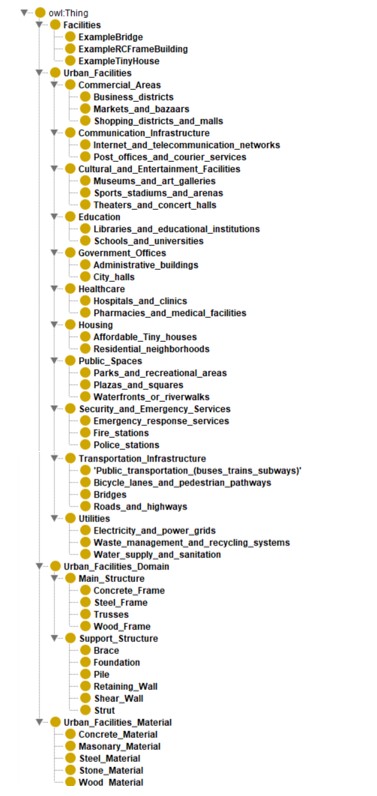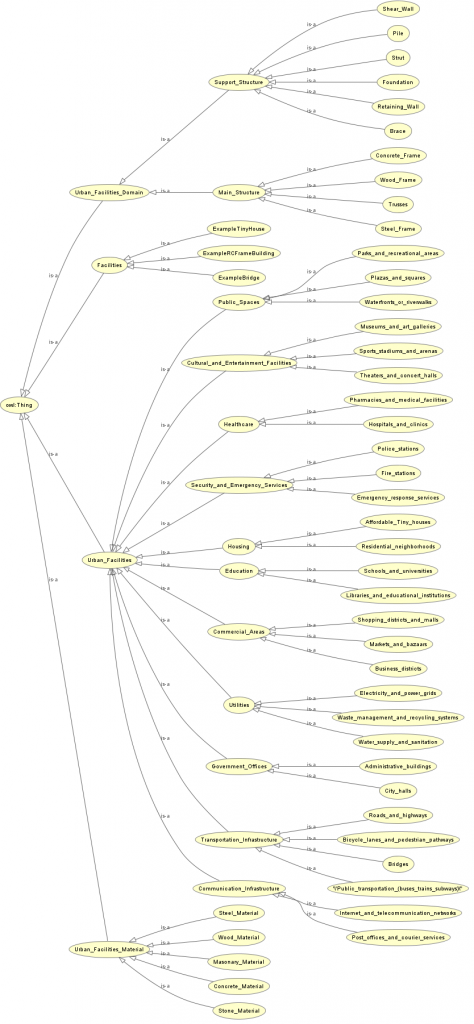Introduction
The integration of ontologies is a crucial aspect of knowledge management and semantic web technology. Ontologies are formal representations of knowledge that capture the conceptual relationships between different entities in a specific domain. Integrating ontologies involves merging multiple ontologies or aligning disparate ontologies to create a more comprehensive and coherent representation of knowledge. To create a good ontology (Noy & McGuinness, 2001) suggest answering some questions as described below:
- What is the purpose?
The purpose of an ontology about urban facilities is to provide a structured representation of knowledge about the various components, characteristics, and relationships within urban facilities. This ontology aims to capture the complex and interconnected nature of urban infrastructure, such as buildings, roads, utilities, public spaces, transportation systems, and other physical assets in urban environments. - What is the scope?
The Urban Facilities Ontology is a structured classification system that categorizes the necessary elements for urban planning and development. The ontology will cover both structural and material aspects of the Urban planning system and comprehensive understanding of its structure. It identifies various facilities as class for urban areas and present at least two subclasses for each. The subclasses are organized based on their main and support structures and at the end an instance is presented for every one of subclasses. - Who are the intended users?
The ontology provides a comprehensive framework for the intended users like: urban planners and developers to analyze, assess, and improve urban infrastructure. - What is the intended use?
The ontology will be used to model urban facilities, enabling engineers to design and construct the new location effectively. Additionally, it also provides insight for city designers and contractors on equipment and earthwork that is needed before construction begins. Furthermore, the ontology can be served as a basic model for three subsystems and demonstrate the design threshold for three urban subsystems as an example.
Challenge
One of the main challenges for integrating ontologies is the lack of standardization and compatibility between different knowledge representation languages and frameworks. Ontologies may be developed using different technologies, making it difficult to merge them seamlessly. Additionally, inconsistencies and redundancies in the information contained within different ontologies can hinder the integration process. Another challenge is ensuring that the semantics of the ontologies are aligned, as mismatches can lead to incorrect or incomplete results when integrating data from multiple sources. Therefore, a new concept is defined and presented from the initiation in order to integrate four ontologies.
Class Hierarchy
We must infer certain axioms to map out components for our combined ontology and establish relationships between them. We began by establishing our classes and subclasses on the Classes tab of Protégé. The class hierarchy for the combined ontological model can be seen below:
Ontograf
In the Software Protégé, the plug-in OntoGraf is used to visualize the ontology. After the consideration of classes, hierarchy, and their relations in form of axioms we made a visualization of the combined ontology which can be seen below:
The classes and subclasses can more clearly be seen in the diagram below:
← Integration Context | Group A – Homepage | Combined Parametric Model →



